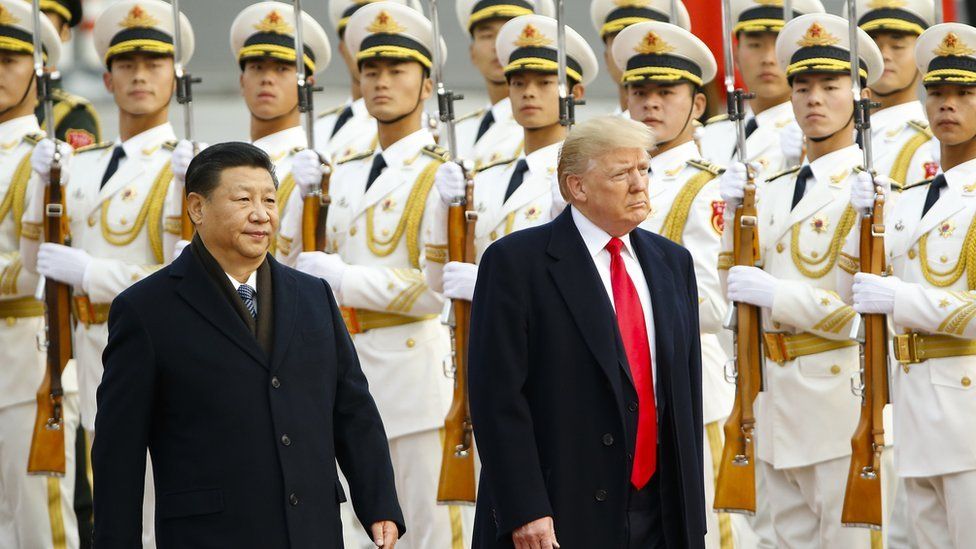Trump's trade war: Stakes are high at G20 summit
- Published

The stakes are high at this week's G20 summit, where President Trump is due to meet China's President Xi Jinping.
Hopes that the meeting could open the way for a deal over trade between the two countries have been undermined by recent threats by the US president.
Only days before the summit in Argentina, President Trump said current tariff levels on $200bn (£157bn) of Chinese imports would rise as planned.
He also threatened tariffs on $267bn of other Chinese exports to the US.
Then, just before taking off for Argentina, President Trump told reporters at the White House that while China was interested in striking a deal, "I don't know if I want to do it" and "I like the deal we have now".
The stage could now be set for a possible escalation of the trade war between the two nations.
What is likely to come out of the meeting?
President Trump started the dispute with China earlier this year, accusing the Chinese of "unfair" trade practices and intellectual property theft.
The US has hit a total $250bn of Chinese goods with tariffs since July, and China has retaliated by imposing duties on $110bn of US products.
So how does a G20 summit work?
China had already hit the US with $3bn of tariffs in April, in response to US tariffs on global steel and aluminium imports.
President Trump offered a glimmer of hope earlier this month, when he said he thought the US could strike a trade deal with China.
But only days before the summit, he poured cold water on such optimism.
President Trump told the Wall Street Journal he expected to go ahead with plans to raise tariffs on $200bn of Chinese goods - first introduced in September - to 25% (up from 10%) starting in January 2019.
President Trump also said that if talks were unsuccessful, he would carry out a threat to hit the remaining $267bn of annual Chinese exports to the US with tariffs of 10-25%.
The Trump administration also recently accused China of not changing its "unfair" trade practices.
"I think the most likely scenario is that Xi Jinping doesn't offer big enough concessions to Trump, and so nothing much comes of the G20 meeting," says Julian Evans-Pritchard from Capital Economics.
Recent summits also do not bode well for any resolutions at the G20 level.
The Asia-Pacific Economic Cooperation (Apec) summit recently ended without a formal leaders' statement because of US-China divisions over trade.
And a G7 summit in Canada in June ended in disarray as Trump retracted his endorsement of the joint statement.
"I think unfortunately, the US and China remain quite far apart in the issues behind the trade conflict, so we are not too optimistic," says Valerie Mercer-Blackman, senior economist at the Asia Development Bank.
"Failure to agree on the communique at the Apec meeting... also suggests that there is quite substantial distance between the two sides, and there doesn't seem to be a specific proposal on the table yet to end the impasse."
What's at stake?
The stakes are high.
"If the meeting fails to deliver a truce, then the US will almost certainly hike tariff rates [on $200bn of existing Chinese goods] in January, and a further expansion in tariffs is quite likely," says Mr Evans-Pritchard.
A rise in those tariffs would see many multinational firms accelerate their plans to move supply chains away from China, while tariffs on additional Chinese imports would pose "a significant political and economic risk for Trump", says Michael Hirson, Asia director at Eurasia Group.
"Remaining US imports from China are more heavily tilted towards consumer items. American households, especially those from lower income brackets, will feel the impact more than they have over tariffs on previous rounds," he adds.
What happens next?
If the US were to impose tariffs on additional Chinese goods, China could seek to retaliate, but would have limited room to do so via trade.
This is because China's existing $113bn tariffs on US goods are not far from the $130bn it imported from the US in 2017.
Global Trade
Instead of fighting back aggressively with more tariffs, China is more likely to defend its economy by easing fiscal and monetary policy, letting its currency fall and forging trade deals with other countries, analysts say.
"China's strategy towards Trump will favour resilience over retaliation," Mr Hirson says.
If the conflict between China and the US continues to escalate, non-tariff barriers particularly in the technology sector are likely to become increasingly popular.
The US has already made moves in this direction. It recently restricted American firms from selling parts to a Chinese company over national security concerns.
"While tariffs draw most of the attention, non-tariff measures are just as important in this trade war and will probably be in play for much longer," says Mr Hirson.
"On the US side, this includes measures such as recently passed legislation that tightens investment restrictions and export controls... In China, it involves using regulatory tools such as anti-trust investigations to squeeze US tech firms and tip the advantage to domestic competitors."
- Published27 November 2018
- Published18 September 2018
- Published26 October 2018
- Published16 January 2020
- Published20 July 2018
- Published5 August 2018
- Published21 November 2018
- Published16 November 2018